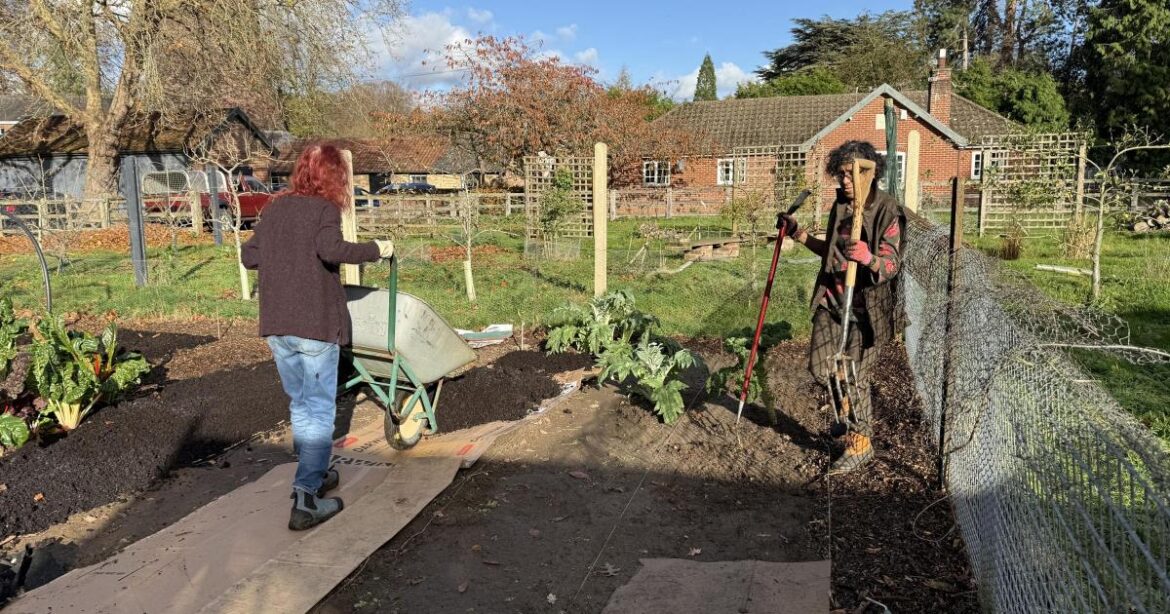We found a few tender plants still outside just before it got really cold, but managed to get most of them into the protection of the greenhouse just in time.
A few others were wrapped in fleece in the garden, including the half-hardy salvias, S. Phyllis Fancy and S. Amistad.
This week we will get out all of the polystyrene boxes and old horticultural fleece which we have been using each winter for the past six years.
Succulents & pelargoniums overwintering in the greenhouse (Image: Norfolk School of Gardening)
We will be adding some wool packaging which one of our students collected for us from a bakery in Norwich (I think their cheese and butter supplier sent boxes lined with these wool-filled pads) and are hoping that all of this will be enough to keep our precious plants alive in the coming months.
The Certificate in Practical Horticulture students had an incredibly wet day for their revision session.
Certificate in Practical Horticulture propagation revision (Image: Norfolk School of Gardening)
It’s quite unusual to have a day when the rain doesn’t let up for a moment, but it was constant last Friday.
We were able to do everything inside the polytunnel and greenhouse, from propagation to training climbers and even from pruning to tree planting.
They went away feeling pretty confident about the upcoming assessment when the forecast is a lot better.
This is a great time of year to be reflecting on what you have done in the garden this year and what you would like to do differently next.
Renovating pruning a Cotinus – after (Image: Norfolk School of Gardening)
Whether you are starting out in your garden or are a seasoned pro, you might want to think about making a month-by-month plan so that you keep up with the jobs that need doing, from flower beds to lawn and from veg patch to paths.
Our Annual Maintenance Plan course is a great way to get ahead for next year, helping you put together a bespoke calendar for your own garden.
There are spaces on this course next week if you would like to join us.
If you would like to make your own wreath for your door or table centre this Christmas, it’s not too late to join one of our lovely festive workshops.
We will be using locally foraged foliage, berries and seedheads and sustainably grown moss.
You will make a truly unique wreath, inspired and guided by Sarah Hammond, local flower farmer.
Renovating pruning a Cotinus – after (Image: Norfolk School of Gardening)
We start with coffee and homemade biscuits and end with a glass of fizz and homemade mince pies.
It’s a lovely way to get into the festive mood in the next couple of weeks.
Get in touch to book one of the last spots.
Upcoming courses:
– Developing an Annual Maintenance Plan – 26 November
– Christmas Wreath Workshops – 28 November, 4 & 5 December
– Introduction to Garden Design – from 8 January
– Certificate in Practical Horticulture – from 9 January
– Advanced Practical Gardening – 14 January
Liriope muscari (Image: Norfolk School of Gardening)
Plant of the Week
Liriope muscari, often called lilyturf, is a tough, evergreen perennial native to East Asia.
It forms neat clumps of arching, grass-like leaves that provide year-round structure.
In late summer and early autumn, it sends up short spikes of violet or lavender flowers, which are followed by glossy black berries that persist into winter.
Liriope muscari thrives in sun or partial shade and is particularly useful for brightening difficult, dry, or shady areas under trees and shrubs.
It prefers well-drained soil and is remarkably low-maintenance.
Divide clumps in spring if needed, and use it as ground cover, edging, or for softening paths.
Contact us via www.norfolkschoolofgardening.co.uk or follow us on Instagram or Facebook.


Comments are closed.